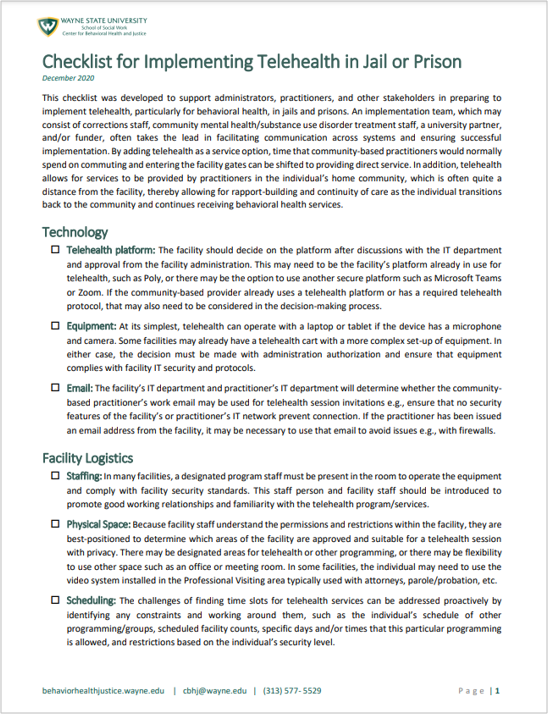CBHJ develops telehealth checklist to support jails and prisons in implementing behavioral telehealth services during COVID-19 and beyond
 Staff members on the reentry team at the Wayne State University School of Social Work Center for Behavioral Health and Justice have compiled a checklist for jails and prisons seeking to implement telehealth, particularly for behavioral health. The checklist provides administrators and practitioners with key considerations in the areas of Technology; Facility Logistics; Staffing, Collaboration, and Program Promotion; and Evaluation and Feedback.
Staff members on the reentry team at the Wayne State University School of Social Work Center for Behavioral Health and Justice have compiled a checklist for jails and prisons seeking to implement telehealth, particularly for behavioral health. The checklist provides administrators and practitioners with key considerations in the areas of Technology; Facility Logistics; Staffing, Collaboration, and Program Promotion; and Evaluation and Feedback.
Re-entering the community after incarceration is a stressful time, and additional challenges are posed for those with substance use and/or mental health disorders. Providing behavioral health re-entry services pre- and post-release supports individuals as they transition to life in the community. Offering those services via telehealth in jails and prisons provides considerable benefits to providers, clients, and the involved systems overall. Time that providers would normally spend on commuting and entering the facility's gates can be shifted to providing services to additional clients. In addition, telehealth allows for appointments with providers in the individual's home community, which is often quite a distance from the facility, thereby allowing for rapport-building and continuity of care as the individual transitions back to the community.
Over the past year, CBHJ staff have been working with correctional facilities around the state to pilot telehealth services for mental health and substance use disorder treatment. During the COVID-19 pandemic, it has been even more important because many facilities have had to put strict regulations in place on visitation and programming to control spread of the virus. Based on findings from these pilots, the CBHJ has created the Checklist for Implementing Telehealth in Jail or Prison to support administrators, practitioners, and other stakeholders in this endeavor. CBHJ staff are in a unique position to create this checklist based on observation and feedback from all involved (e.g., IT, facility administration, program coordinators, community-based providers, and clients).
With the October 1 release of State Opioid Response-2 (SOR2) funding from the Michigan Department of Health and Human Services (MDHHS) via SAMHSA, the CBHJ is working in partnership with the Michigan Department of Corrections (MDOC) to expand behavioral health telehealth programming to five additional prisons throughout the state. The checklist is currently being used as a planning and pre-implementation guide as the CBHJ and MDOC team meet with each prison facility.
The checklist is free and available to the public.
About the Center for Behavioral Health and Justice: The Wayne State University School of Social Work Center for Behavioral Health and envisions communities in which research, data, and best practices are used by multiple stakeholders to enhance the optimal well-being of individuals with mental illness and/or substance use disorders who come into contact with the criminal/legal system. Learn more
About the Michigan Re-entry Project (MIREP): The Michigan Re-entry Project (MIREP) was implemented in 2017 with funding from SAMHSA's State Targeted Response to the Opioid Crisis and expanded with State Opioid Response funding in 2019. MI-REP utilizes the evidence-based MISSION-CJ model to provide support for incarcerated individuals with co-occurring opioid use and mental health issues. Clinical teams in three prisons and two jails provide case management and peer support services for three months prior to release and six months following community re-entry to individuals re-entering five Michigan counties. Learn more